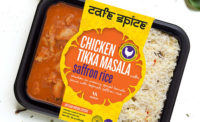Flavorful functionality of marinades
Marinating has been a major contributor of the global food architecture for thousands of years, for it serves as a foundation to many chefs’ signature dishes. Commonly used to flavor foods, tenderize tougher cuts of meat or firm vegetables, marinades generally contain one or more of the following: seasonings (salt, spices, aromatic herbs and vegetables), acids (vinegar, wine, yogurt or citrus juices) and oil.
Marinades can be applied externally or internally. For example, a wet marinade of olive oil, lemon juice, herbs and spices could be applied in a “static method,” where a tender fillet portion or vegetable is soaked in marinade until the proper flavor and texture is met, or the marinade is deposited in a vacuum pouch with a protein.
A dry rub usually consists of salt and seasonings and is applied to the surface of a product to impart flavor, texture and often, color. A glaze, wet rub or paste-style marinade coats the surface of a product with dry seasonings mixed with ingredients like fresh herbs, ground nuts or fruit purees.
“Internal marinades” consist of tumble-marinating and injection. With tumble-marinating, a concentrated marinade mixture and smaller, more durable raw materials are placed in a sealed drum under vacuum, to assist in opening up the filaments of a muscle and to let the marinade penetrate and infuse flavor in a short period of time.
Injection requires a fine marinade or brine with little or no particulate pumped through needles penetrating the muscle with the marinade; this also assists in tenderizing, by breaking the muscle structure.
Marinade Techniques Spark Infusion
Brining is a marinating technique that assists in adding and retaining moisture in cooked proteins, especially in larger, tougher cuts of meat, where size, time and salt level are critical. Regional American barbecue is a great example. In this case, a beef brisket is brined with brown sugar and sea salt, rubbed with a bold chile powder seasoning blend and smoked with hickory chips for 12 hours. Salt disrupts the muscle structure and - with a 3% salt solution or a light brine of 1 part salt, 1 part sugar to 2 parts very cold water (which helps open up filaments of the muscle) - breaks down the protein structure to develop tenderizing qualities. It increases the water-holding capacity of the muscle, resulting in a juicier product.
Sometimes, simple is better. A Mediterranean-style marinade could give subtle flavor to an already rich and complex protein, such as wild Alaska sockeye salmon, using a good fruity olive oil, freshly grated orange rind, shallots, lemon thyme and smoked paprika. A Korean-style bulgalbi marinade on short ribs, with soy sauce, sesame oil and garlic, could have sweetness imparted through the addition of blackberry puree and the acid of rice vinegar.
Marinating and brining are great ways to bring a complexity of flavors to the table, when targeting specific traditional and contemporary recipes. Choose a specific protein with the right flavor-enhancing system and one that helps guarantee a moister and more flavorful meal experience for the consumer.
Note: This article originally appeared in the February, 2010 issue of Prepared Foods magazine. To read the article in its entirety, go to http://bit.ly/9LntGR
Looking for a reprint of this article?
From high-res PDFs to custom plaques, order your copy today!





